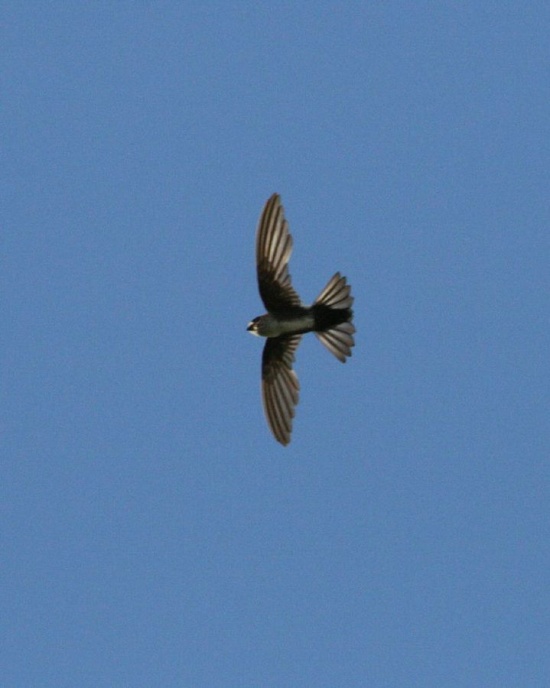(Photo caption. Subspecies expanded with reference updated to 2008) |
|||
| Line 1: | Line 1: | ||
| − | [[Image:Antillean_Palm_Swift.jpg|thumb|550px|right|Photo by {{user|Conorbirda2|Conorbirda2}}<br /> | + | [[Image:Antillean_Palm_Swift.jpg|thumb|550px|right|Photo by {{user|Conorbirda2|Conorbirda2}}<br />Punta Cana, [[Dominican Republic]], June 2008]] |
;[[:Category:Tachornis|Tachornis]] phoenicobia | ;[[:Category:Tachornis|Tachornis]] phoenicobia | ||
| − | |||
==Identification== | ==Identification== | ||
Mostly black upperside with white rump. Mostly white underside with a thin dark breast band. Sides of head is dark grey-brown, not black. Immature has buffy instead of white underside. <sup>[[#References|[1]]]</sup> | Mostly black upperside with white rump. Mostly white underside with a thin dark breast band. Sides of head is dark grey-brown, not black. Immature has buffy instead of white underside. <sup>[[#References|[1]]]</sup> | ||
| − | |||
==Distribution== | ==Distribution== | ||
[[Cuba]], [[Isle of Pines]], [[Jamaica]] and [[Hispaniola]]. Vagrant to [[Puerto Rico]] and accidental vagrant to [[Florida]] (1 record). | [[Cuba]], [[Isle of Pines]], [[Jamaica]] and [[Hispaniola]]. Vagrant to [[Puerto Rico]] and accidental vagrant to [[Florida]] (1 record). | ||
| − | |||
==Taxonomy== | ==Taxonomy== | ||
| − | + | ====Subspecies<sup>[[#References|[1]]]</sup>==== | |
| − | + | *''T. p. iradii'': | |
| + | :*[[Cuba]] and Isle of Pines | ||
| + | *''T. p. phoenicobia'': | ||
| + | :*[[Jamaica]], [[Hispaniola]], Saona, Beata and Île-á-Vache | ||
==Habitat== | ==Habitat== | ||
Lowlands and low mountains. | Lowlands and low mountains. | ||
| − | |||
==Behaviour== | ==Behaviour== | ||
| + | ====Diet==== | ||
The diet consists of insects which are caught at less than 20 m/65 ft above ground. | The diet consists of insects which are caught at less than 20 m/65 ft above ground. | ||
| − | + | ====Breeding==== | |
Nesting is colonial, taking place in March/April, most often in palms or tobaco sheds<sup>[[#References|[1]]]</sup>. | Nesting is colonial, taking place in March/April, most often in palms or tobaco sheds<sup>[[#References|[1]]]</sup>. | ||
| − | |||
==References== | ==References== | ||
# Raffaele et al. 1998. Birds of the West Indies. Christopher Helm, London. ISBN 0713649054 | # Raffaele et al. 1998. Birds of the West Indies. Christopher Helm, London. ISBN 0713649054 | ||
| − | # | + | #{{Ref-Clements6thDec08}} |
| − | + | {{ref}} | |
==External Links== | ==External Links== | ||
{{GSearch|Tachornis+phoenicobia}} | {{GSearch|Tachornis+phoenicobia}} | ||
[[Category:Birds]][[Category:Tachornis]] | [[Category:Birds]][[Category:Tachornis]] | ||
Revision as of 21:17, 23 June 2009
- Tachornis phoenicobia
Identification
Mostly black upperside with white rump. Mostly white underside with a thin dark breast band. Sides of head is dark grey-brown, not black. Immature has buffy instead of white underside. [1]
Distribution
Cuba, Isle of Pines, Jamaica and Hispaniola. Vagrant to Puerto Rico and accidental vagrant to Florida (1 record).
Taxonomy
Subspecies[1]
- T. p. iradii:
- Cuba and Isle of Pines
- T. p. phoenicobia:
- Jamaica, Hispaniola, Saona, Beata and Île-á-Vache
Habitat
Lowlands and low mountains.
Behaviour
Diet
The diet consists of insects which are caught at less than 20 m/65 ft above ground.
Breeding
Nesting is colonial, taking place in March/April, most often in palms or tobaco sheds[1].
References
- Raffaele et al. 1998. Birds of the West Indies. Christopher Helm, London. ISBN 0713649054
- Clements, JF. 2008. The Clements Checklist of Birds of the World. 6th ed., with updates to December 2008. Ithaca: Cornell Univ. Press. ISBN 978-0801445019.
Recommended Citation
- BirdForum Opus contributors. (2024) Antillean Palm Swift. In: BirdForum, the forum for wild birds and birding. Retrieved 1 November 2024 from https://www.birdforum.net/opus/Antillean_Palm_Swift




